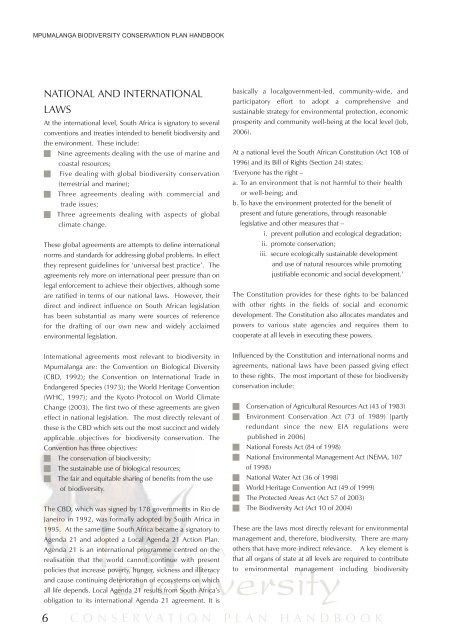Mpumalanga Biodiversity Conservation Plan Handbook - bgis-sanbi
Mpumalanga Biodiversity Conservation Plan Handbook - bgis-sanbi
Mpumalanga Biodiversity Conservation Plan Handbook - bgis-sanbi
Create successful ePaper yourself
Turn your PDF publications into a flip-book with our unique Google optimized e-Paper software.
MPUMALANGA BIODIVERSITY CONSERVATION PLAN HANDBOOK<br />
NATIONAL AND INTERNATIONAL<br />
LAWS<br />
At the international level, South Africa is signatory to several<br />
conventions and treaties intended to benefit biodiversity and<br />
the environment. These include:<br />
Nine agreements dealing with the use of marine and<br />
6<br />
coastal resources;<br />
Five dealing with global biodiversity conservation<br />
(terrestrial and marine);<br />
Three agreements dealing with commercial and<br />
trade issues;<br />
Three agreements dealing with aspects of global<br />
climate change.<br />
These global agreements are attempts to define international<br />
norms and standards for addressing global problems. In effect<br />
they represent guidelines for ‘universal best practice’. The<br />
agreements rely more on international peer pressure than on<br />
legal enforcement to achieve their objectives, although some<br />
are ratified in terms of our national laws. However, their<br />
direct and indirect influence on South African legislation<br />
has been substantial as many were sources of reference<br />
for the drafting of our own new and widely acclaimed<br />
environmental legislation.<br />
International agreements most relevant to biodiversity in<br />
<strong>Mpumalanga</strong> are: the Convention on Biological Diversity<br />
(CBD, 1992); the Convention on International Trade in<br />
Endangered Species (1973); the World Heritage Convention<br />
(WHC, 1997); and the Kyoto Protocol on World Climate<br />
Change (2003). The first two of these agreements are given<br />
effect in national legislation. The most directly relevant of<br />
these is the CBD which sets out the most succinct and widely<br />
applicable objectives for biodiversity conservation. The<br />
Convention has three objectives:<br />
The conservation of biodiversity;<br />
The sustainable use of biological resources;<br />
The fair and equitable sharing of benefits from the use<br />
of biodiversity.<br />
The CBD, which was signed by 178 governments in Rio de<br />
Janeiro in 1992, was formally adopted by South Africa in<br />
1995. At the same time South Africa became a signatory to<br />
Agenda 21 and adopted a Local Agenda 21 Action <strong>Plan</strong>.<br />
M P U M A L A N G A<br />
Agenda 21 is an international programme centred on the<br />
<strong>Biodiversity</strong><br />
realisation that the world cannot continue with present<br />
policies that increase poverty, hunger, sickness and illiteracy<br />
and cause continuing deterioration of ecosystems on which<br />
all life depends. Local Agenda 21 results from South Africa’s<br />
obligation to its international Agenda 21 agreement. It is<br />
basically a localgovernment-led, community-wide, and<br />
participatory effort to adopt a comprehensive and<br />
sustainable strategy for environmental protection, economic<br />
prosperity and community well-being at the local level (Job,<br />
2006).<br />
At a national level the South African Constitution (Act 108 of<br />
1996) and its Bill of Rights (Section 24) states:<br />
‘Everyone has the right –<br />
a. To an environment that is not harmful to their health<br />
or well-being; and<br />
b. To have the environment protected for the benefit of<br />
present and future generations, through reasonable<br />
legislative and other measures that –<br />
i. prevent pollution and ecological degradation;<br />
ii. promote conservation;<br />
iii. secure ecologically sustainable development<br />
and use of natural resources while promoting<br />
justifiable economic and social development.’<br />
The Constitution provides for these rights to be balanced<br />
with other rights in the fields of social and economic<br />
development. The Constitution also allocates mandates and<br />
powers to various state agencies and requires them to<br />
cooperate at all levels in executing these powers.<br />
Influenced by the Constitution and international norms and<br />
agreements, national laws have been passed giving effect<br />
to these rights. The most important of these for biodiversity<br />
conservation include:<br />
<strong>Conservation</strong> of Agricultural Resources Act (43 of 1983)<br />
Environment <strong>Conservation</strong> Act (73 of 1989) [partly<br />
redundant since the new EIA regulations were<br />
published in 2006]<br />
National Forests Act (84 of 1998)<br />
National Environmental Management Act (NEMA, 107<br />
of 1998)<br />
National Water Act (36 of 1998)<br />
World Heritage Convention Act (49 of 1999)<br />
The Protected Areas Act (Act 57 of 2003)<br />
The <strong>Biodiversity</strong> Act (Act 10 of 2004)<br />
These are the laws most directly relevant for environmental<br />
management and, therefore, biodiversity. There are many<br />
others that have more indirect relevance. A key element is<br />
that all organs of state at all levels are required to contribute<br />
to environmental management including biodiversity<br />
CONSERVATION PLAN HANDBOOK

















